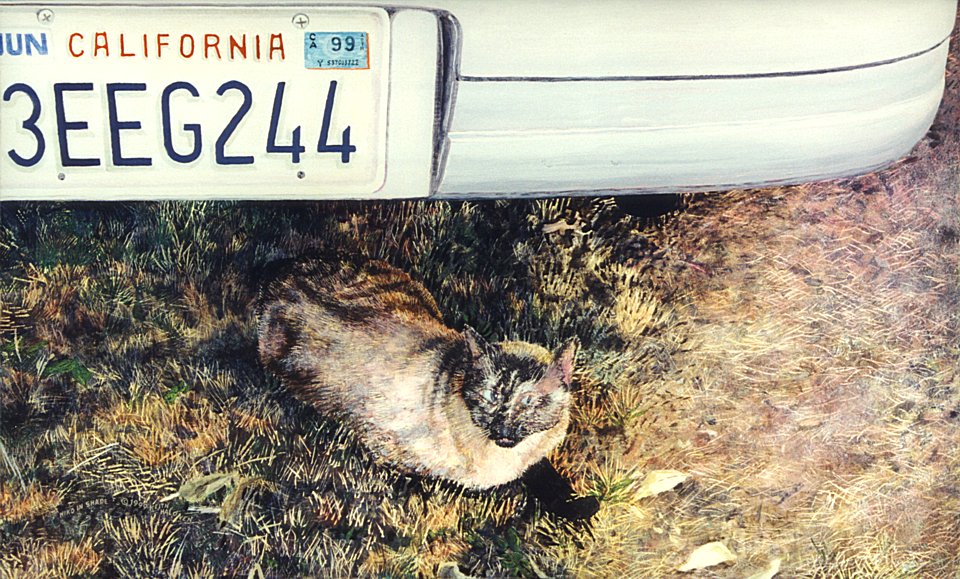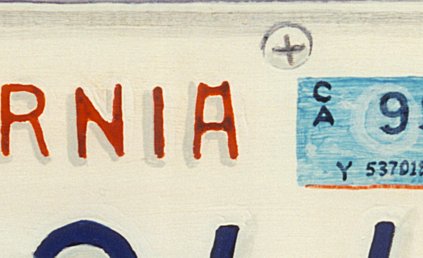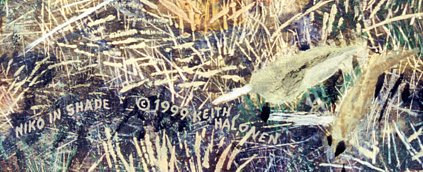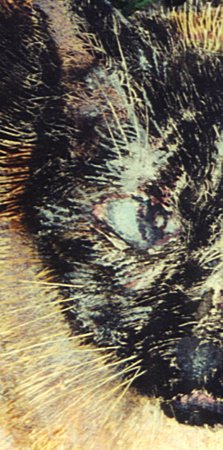|
|

|
|
NIKO IN SHADE
© 1999 Keith Halonen oil on panel 18¼×11 in / 46×28 cm $ 3,300 US THIS PAINTING IS A GOLDEN RECTANGLE |

|
« CLICK to contact the artist |




|
CLICK » to order this print |

|
|
YOU ARE IN THE ANIMAL PAINTINGS GALLERY
CLICK THE SHORTCUT ICONS ABOVE TO VIEW MORE PAINTINGS |
|
My perpetually talkative Tortoise Shell Siamese cat Niko sometimes took her shade under a car. This was odd considering that she had been struck by vehicles several times in her early youth. The first incident cost her only some nail tissue. She was later blinded in her left eye, though the orb survived. It continued to atrophy and I administered a daily eyedrop fortified with antibiotic to prevent infection from dust and pollen which crept into the widening gap between the shrinking orb and its socket. Impaired vision really didn't help with her efforts at crossing the street.
Her worst accident peeled the flesh down from her knees to her ankles! She looked like furry, bloody stockings had fallen to her feet. After months in bandages she heeled wonderfully except for one permanently maimed toe which sported an unretractable nail. She eventually acquired the "street wisdom" neccessary to resist the urge to hunt in the field across the street. Animals do not fare well in the human milieu. Niko the cat appears in several of my paintings. She was generally found in the vicinity of my studio when I was at the easel. Her desire for protective companionship during nap time induced her to enjoy her rest at my feet while I worked. Little Niko died in February, 2007,two weeks after her nineteenth birthday. It is very quiet around here, now. |
 
|

|
|
|
Detail from NIKO IN SHADE
|
|
Behold the miracle of a license plate! This fairly subtle light and shadow work underscores the importance to the realist painter of careful observation. The license plate is so vividly ceramic white that the tendency would be to simply depict it as brilliant white. Closer scrutiny reveals the many shades of pale hues which visually define the planes of the plate's surface.
Here also are closeup views of line technique in the cat's pelt and in the grass. First a basic color is applied, which I will sometimes refer to as the foundation color. It's applied more intensely than it finally appears since it will be covered by other glazes and opaques. It's a mid-tone and I work over it with lighter and darker paints. At several stages I use toothed tools such as sections of comb, forks, serrated knife blades, even a single point stylus. This last tool is used to cross-incise the typical random individual hairs and/or grass blades. This prevents comb tool techniques from creating artificially uniform cross hatch patterns. These tined tools all perform the function of scoring through the still-wet surface paint layers to reveal foundation color in a stylized imitation of the direction of the animal's coat or the grass blades. With a modicum of force, the stylus can be used even after the paint is dry. Scumbling and drybrush techniques add the finishing touches needed to create a very realistic representation of fur and field. |
———————— GALLERIES ————————









|